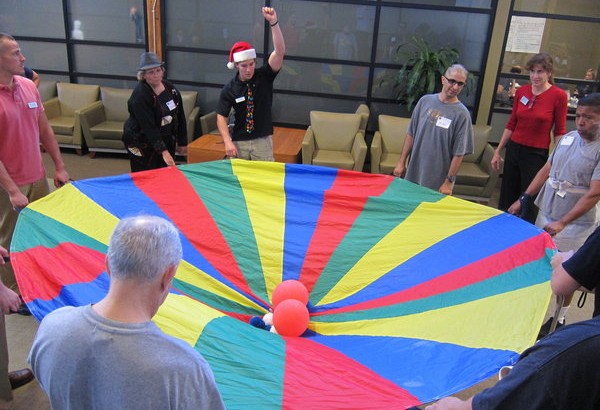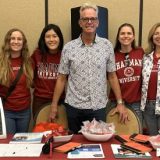
Basic Training for Stroke Victims
June 26, 2014
This article, written by Joe Yogerst, originally appeared on the Los Angeles Times website.
Chapman’s Department of Physical Therapy offers a “boot camp” that takes a creative approach to rehab.
Alison McKenzie
’s stroke boot camp looks nothing like a traditional physiotherapy session. On any given day there might be a competitive game of wheelchair hockey or Guitar Hero. Campers might be clad in commando outfits, crawling across the floor Marine-style through an obstacle course with mock barbed wire — or even paddleboarding on dry land with Beach Boys music blasting in the background.
“All activities are really geared toward working on coordination, balance and strength,” said McKenzie, a professor at the
Department of Physical Therapy
at Chapman University.
“Our goal is to use the same principles and the same kinds of activities that we know will help recovery — rewiring the brain and regaining function,” she said. “But we try to make it so it’s fun and people don’t realize how hard they are working. And we try to make it a little bit more sociable, too.”
Another way the Chapman sessions differ from traditional hospital or outpatient stroke therapy is the level of intensity — up to six hours a day. “Even with inpatient rehab, research shows that for every hour of therapy, you do about a half hour of active work. So we try to keep people moving,” McKenzie said.
According to the American Heart Assn., nearly 800,000 Americans have strokes each year — one every 40 seconds — and stroke ranks No. 4 among all causes of death. The good news is there has been a decline in stroke mortality over the past few decades; the bad news is that the vast majority of these survivors are left with physical and mental challenges.
“Stroke is the leading cause of disability in the U.S. and we need to be doing a better job of providing services to people,” McKenzie said.
This summer will mark the fourth year in a row that McKenzie and Chapman have organized their boot camp for stoke survivors. It will be a five-day course over a two-week period, with enrollment limited to no more than 25 people.
Participants have ranged in age from 19 to mid-80s. McKenzie says a lot of them are working-age people who fall into a sort of “no-man’s land” when it comes to health insurance.
“They had insurance through their employer and then they become disabled, and once their disability and insurance benefits expire, they lose that job and they lose insurance,” she explained.
“Often they have enough resources so they don’t qualify for Medi-Cal yet, so they have no ability to pay for additional services. They get stuck in this bind that they get disabled so they can’t work or only work on a limited basis. I’m curious to see how that might change in the coming years.”
McKenzie believes that one of the strengths of the Chapman program is the interaction that participants have with one another and the support network that grows out of attending the camp.
“The next thing you know there’s this whole posse of people going to the gym to work out together. The ongoing networking and social and psychological support they give one another — sharing information, sharing resources — that was a pleasant surprise.”
If you would like to support Chapman’s Physical Therapy programs- including events like Stroke Boot Camp- you may now do so through the program’s new online giving portal.

